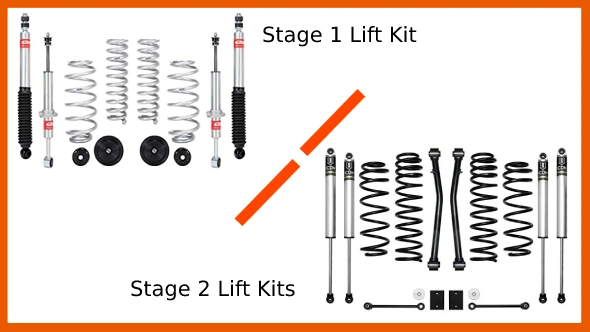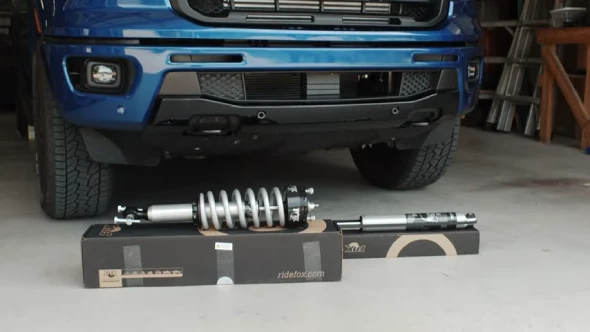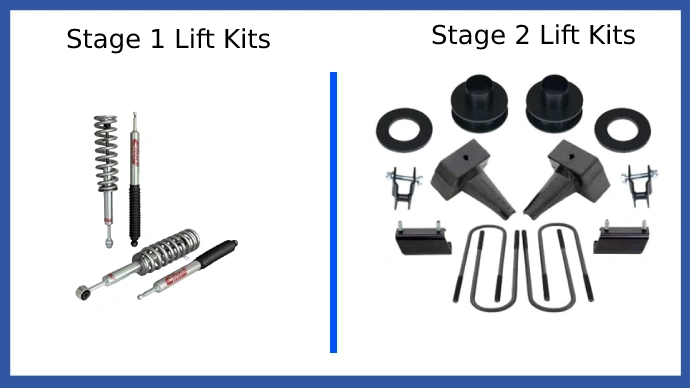Last Updated on April 5, 2023
Two shrewd options are available when upgrading your suspension system: Stage 1 and Stage 2 lift kits. Both offer benefits depending on the type of use you intend for your vehicle, but significant differences lie in their components.
While both offer basic lifts with springs and shocks, a stage 2 kit includes upgrades such as greater adjustability and increased lift height. Stage 1 lift kit is an entry-level kit that provides a basic lift, while Stage 2 is a more advanced suspension upgrade with additional components for light to medium off-road use.
Whether you’re hoping for improved performance or just want some extra off-roading capabilities, understanding the differences between these two lifts will help you make an informed decision that meets your needs. Keep reading if you’re ready to take the next step toward optimizing your vehicle’s performance.
Difference Between Stage 1 and Stage 2 Lift Kits: Solve the Conundrum

There are various levels and components to consider when looking for a suspension lift kit. Stage 1 and 2 kits offer different features and capabilities depending on the type of vehicle, terrain, and desired look.
Here are some of the primary differences between these two lift kits:
Suspension Components Included
Stage 1 Lift Kits typically include the front coil spring overs with drop brackets and rear lift springs or shocks. If properly installed, this provides a moderate suspension lift without requiring significant frame modifications. The drop brackets allow the existing radius arms to be utilized while providing clearance for larger tires.
Stage 2 Lift Kits generally include major components, such as front coilovers with the upper control arm and rear upper/lower control arms. When properly installed, this allows for more aggressive off-roading but requires more extensive frame modifications than installing drop brackets.
Also, extended radius arms may be included in Stage 2 kits, providing improved articulation over stock models. You can also get dual shock setups with these kits, which allow for better dampening and more durability off-road by spreading force out between multiple shock absorbers instead of just one.
Lifting Height Increase
The Stage 1 Lift Kit increases the lifting height of the vehicle by about 2.75 inches in front and 1 inch in the back. This is an excellent choice for those looking to achieve an aggressive lifted look without investing too much money into their purchase.
Stage 2 Lift Kits provide even greater lift potential than Stage 1 kits, ranging from two to four inches of added height, depending on your chosen kit. This added height improves stability, handling, and greater protection against rocks and other obstacles when off-roading.
Off-Road Capability & Performance
Stage 1 lift kits provide increased ground clearance and suspension dampening and give your vehicle an aggressive look. The additional room allows you to fit larger tires, giving you better traction on rough terrain. This stage is ideal if you’re looking for a slightly improved off-road experience without going too far with modifications.
On the other hand, Stage 2 lift kits provide a more comprehensive upgrade of your vehicle’s off-road capability and performance. This includes installing aftermarket shocks and struts specially designed for off-road use.
These components offer greater support and stability when traveling over uneven terrain or challenging slopes, making them perfect for medium off-road activities.
Ride Quality Differences
The ride quality of stage 1 and stage 2 lift kits vary. The differences between the two stages have to do with the components used and the amount of height increase.
Stage 1 lift kits are designed with minimal components and are generally more affordable than Stage 2 kits. As a result, they also offer fewer ride quality enhancements than Stage 2 lifts. The lack of additional components means that off-road performance may not be as good as it could be with a stage 2 kit.
Stage 2 lift kits come with additional components compared to Stage 1 for increased off-road performance and overall ride quality enhancements. These components will vary depending on the specific kit but usually improve performance while maintaining a comfortable ride over rough terrain or through potholes.
Installation Complexity
Stage 1 lift kits are relatively easier to install than stage 2 kits due to their more simplistic design. Stage 1 lifts involve installing suspension components such as springs, shocks, and control arms that generally don’t require much more than basic mechanical skills.
Stage 2 lift kits require more expertise to install correctly as they include additional parts such as drivetrain components, axles, brakes, and more that can be complex for those with limited mechanical knowledge.
Installation Time & Cost
The installation time and cost associated with each type of kit also vary greatly depending on which one you choose. Stage 1 lifts generally take around 1-3 hours, while stage 2 lifts can take twice as long or even longer, depending on how complicated the kit is.
Also, stage 1 lifts tend to be less expensive due to their more straightforward design, while stage 2 lifts can range anywhere from moderately priced up into the thousands depending on what components are included in the kit.
What are the Limitations of a Stage 1 Lift Kit for Off-Road Performance?

Installing a stage 1 lift kit can help improve your vehicle’s off-road performance, but it is important to understand that certain limitations come with this type of upgrade. These includes:
Limited Increase in Ground Clearance
One of the primary drawbacks of a Stage 1 lifting kit is the limited improvement in ground clearance it provides. This type of kit usually increases ground clearance by up to two inches, which may not be enough to provide the additional protection needed when navigating difficult terrain.
Limited Improvement in Approach/Departure Angles
Stage 1 lift kits are also limited in improving the approach and departure angles. While they may slightly increase these angles, they do not provide significant improvement compared to stock suspension setups or high-end lifts designed for extreme off-roading.
Limited Ability to Accommodate Larger Tires
Another limitation of a stage 1 lift kit is its limited ability to fit larger tires. While this type of kit can provide enough space for some larger tires, it won’t be able to fit all sizes due to its minimal suspension travel and other factors, such as wheel well widths and frame design.
Without fitting larger tires onto your vehicle’s wheels, you won’t be able to take advantage of improved traction in off-road conditions that might otherwise be possible with bigger tires installed on bigger rims or aftermarket wheelsets available on the market today.
Limited Suspension Travel
Lastly, stage 1 lift kits have less suspension travel than higher-end lifts explicitly designed for off-roading applications such as rock crawling or mud bogging events.
With less suspension travel available, this limits how much vertical movement you can achieve while driving over rougher terrain and thus reduces overall stability when traversing challenging trails or obstacles out on the trailhead or track day course.
What are Some Reasons to Choose a Stage 2 Lift Kit Over a Stage 1 Lift Kit?

Whether you’re an off-road enthusiast or just someone who wants to show off with a higher stance, Stage 2 list kits offer several advantages over the popular Stage 1 lift kits, such as:
Improved Stability
A Stage 2 lift kit is the way to go when stabilizing your vehicle when driving on rough terrain. This type of kit allows for larger tires that are better able to absorb shock on uneven surfaces.
Also, the increased wheel track width offered by the larger tires improves handling and stability over rocks and washboards. These larger tires also help keep your truck from rolling in steep hills and turns.
Better Articulation
Another key benefit of installing a Stage 2 lifting kit is improved articulation. The additional height of these kits gives them extra flexibility in articulating over difficult terrain without bottoming out or getting stuck at extreme angles.
This means you can tackle more challenging trails while still having full control over your vehicle’s suspension system.
More Aggressive Stance
If you want to make your truck look meaner and more aggressive, then going with a Stage 2 lift kit is worth considering. The extra height these kits offer makes them perfect for creating an intimidating presence on the road or trail. With its beefier stance, your truck will be sure to turn heads wherever you go.
Accommodate Larger Tires
One big advantage of choosing a Stage 2 lift kit is that it allows larger tires than those permitted with most stock suspension systems or even most Stage 1 lifts. Larger tires will give you better traction when driving off-road and increased power when climbing hills and other obstacles such as rocky trails or mud bogs.
Enhanced Off-Road Capabilities
The additional height provided by a Stage 2 Lift Kit will give you improved ground clearance which can come in handy when tackling tough trails or rock crawling obstacles like large boulders and deep ruts with ease.
You’ll also have better approach/departure angles, allowing smoother transitions between different types of terrain without stalling or getting stuck in awkward positions due to limited clearance space underneath your vehicle’s body panels or suspension components.
Which Stage Lift is Best for Everyday Use, Stage 1 or Stage 2?

It depends heavily on personal preference and budget constraints.
Stage 1 suspension kits are generally geared towards the everyday driver with a light-to-moderate driving style. These kits contain springs and dampers that improve handling and comfort compared to a stock setup.
This makes Stage 1 ideal for those who don’t need the most extreme performance upgrade but still want to enhance their driving experience.
In contrast, Stage 2 suspension offers the ultimate in handling performance at the cost of some comfort. These kits focus on providing maximum grip rather than ride comfort with components like stiffer springs and adjustable dampers that allow you to fine-tune your suspension setup for various conditions.
If you’re regularly driving off-road and want the most extreme performance, a Stage 2 lift is probably the way to go. Alternatively, if you want to improve handling and ride quality without sacrificing comfort, you might want a Stage 1 kit.
Find the Difference Between Lift Kit Stages to Enhance Your Ride
When it comes to outfitting your off-road vehicle with a lift kit, there are several options available. But the differences become apparent regarding Stage 1 and Stage 2 lift kits. The Stage 1 lift kit is the basic kit typically featuring springs and shocks, while Stage 2 is more advanced with additional components.
Both provide increased suspension height as well as improved off-road capability and performance. Still, Stage 2 provides more significant height increases than its predecessor and includes more components in the package.
Depending on the terrain you plan on driving on, some installations may be easier or more cost-efficient for different applications. Ultimately, it is up to you to decide which is best for your needs, but knowing that you have all the information can make that decision informed.
